Anecdotal Vita II
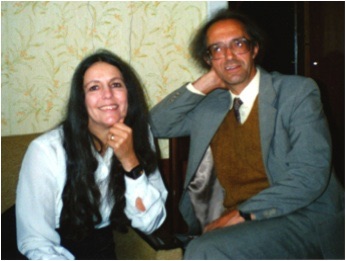
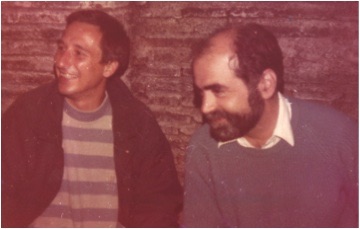
Left: Alice with Vadim Kuzmin in Moscow
Right: Andreas Ringwald and me in Telavi Georgia
A picture of me with Andreas Ringwald shown in the picture above on the right was taken at a meeting in Telavi, Georgia. The meeting was a very interesting one. The issue of whether or not one produced spectacular events in high energy collisions of weakly interacting particles was hotly contested, and almost everyone working on the problems was there. In the night, after the regular meeting, we would sometimes hold discussions in the cellar of the hotel. There would be much Georgian wine and Scotch Whiskey. The discussion would sometimes be very agitated, but all done in good spirit.
Often very late at night, I would gather together with my good friends Sasha Dolgov, Iosif Khriplovich, Victor Novikov and Andrei Smilga, and a young British physicist, Caroline Frasier, and we would drink Georgian wine and Armenian cognac talking of things political, scientific, and cultural. I think the Russian guys were trying to get Caroline drunk, but they were never successful. They however were less than sober by the end of the evening. The last night of the meeting, we had a particularly long discussion. It ended with Andrei Smilga deciding he wanted to go mountain climbing, so in the middle of the night he left the hotel walking in the general direction of the mountains. These mountains are about 100 kilometers distant from Telavi. By morning, he found himself in someone’s orchard on the edge of the city, being challenged by a man with a gun. Andrei got upset by this and reported the guy to the police. They all went to the station and Andrei was strongly encouraged not to make charges as doing so would result in both parties being put in jail. So Andrei gave up, but by that time everyone had left for their planes and trains. Andrei was stuck in Telavi with little money, and a ticket for a flight in Tiblisi which he could not get to on time.
Meanwhile, there had been a train crash in Georgia, and all train traffic was canceled. On my flight leaving Tiblisi there was literally standing room only, and I remember a young German colleague praying as a dangerously overloaded plane left the ground barely gaining enough speed to make it off the runway.
Andrei somehow had or got enough money so that he could call his wife and ask her to help, but by that time his friends were back in Moscow. She had found out what had happened, and would send him no money. I still do not know how he ever got out of Tiblisi.
Caroline Frasier was a promising young theoretical physicist. A few years after this meeting,
she took a trip to Africa. Upon returning to Britain, she fell sick. She went to the public health service
complaining of being very ill, but neglected to mention she had recently returned from Africa and had prematurely stopped taking her malaria medication. The nurse she saw, not being fully informed of the circumstances, recommended aspirin and rest. By the next morning she was dead.
One of the very good friendships I made in Russia was with Valery Rubakov. Valery developed many
of the ideas associated with electroweak baryogenesis. I have shared many hours with him climbing on trails in the Colorado Rockies in search of wild mountain trout. Valery is a one of the top theoretical physicists I have met, but he is even more impressive as a human being. He deeply cared about the young people in Russian science. He has consistently refused offers in the West on the grounds that someone needs to remain in Russia to educate the young. He is painfully honest both in science and personal relations. He will not spare your feelings by telling you a lot of diplomatically phrased half-truths. His friends respect and love him for this simple honesty.
During the time I was in Minnesota, I kept my ties with China. I visited China early after the unfortunate events in Beijing in 1989, for I did not want my Chinese friends to become isolated. As I said above, I think boycotts oftentimes damage those whose support one most needs in order to affect change.
My goal was to make arrangements so that my Chinese friends could also visit us at the Theoretical Physics Institute in Minnesota. I kept the visit very low key, and met only with scientists. I made no visits to touristic spots, nor did I attend banquets with local officials.
As a result of this visit, I succeeded in arranging for a number of Chinese visitors to Minnesota, including my old office-mate at SLAC, Chong-shou Gao. Gao remains a good friend. Life has changed much in China for academics. On my first visit, their apartments were very small, around 15-20 square meters. Now a professor at Peking University might have a 100 square meter apartment near the university in downtown Beijing. The apartments available to scientists will have modern conveniences, and there is no feeling that people are frightened of their government. For a young Chinese scientist of talent, it is now very attractive to return to China.
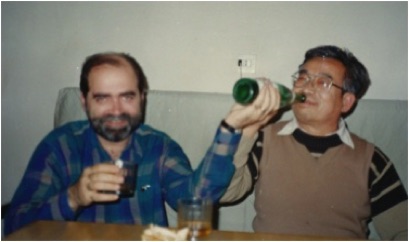
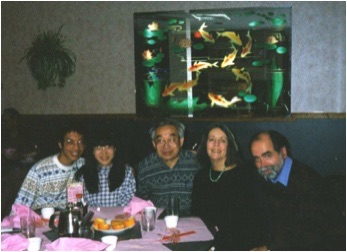
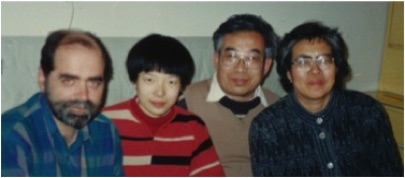
Left: A visit with the Gao’s shortly after the time of Tianamin Square
Above: Gao, his daughter and her husband in Minneapolis
I also helped Gao to arrange for his daughter to enter into the physics graduate school at the University of Minnesota. She married a fellow Chinese graduate student there, and remains in the US.
Towards the end of my stay in Fermilab, a colleague of mine at Fermilab, Gaston Gutierrez arranged for me to visit both Brazil and Argentina. Gaston was at that time married to Sylvia, and they lived a few blocks away from us in Fermilab. Sylvia and her family had been horribly caught up in the violence of the military dictatorship of Argentina. She had been taken for an interview with the secret police, and somehow survived. Friends and a member of her family were not so lucky. By the time I knew her, Argentina had settled down and the dictators were gone.
I remember staying in Buenos Aires in a hotel where they changed the rates every few days. Inflation was very high, and they needed to change the rates so they could keep them at par. I met some of the physicists at the cyclotron lab, but physics was at that time still in disarray. Many of the most famous Argentinan physicists had lost their jobs during the time of the military. Given the academic predisposition to left wing politics and the dictator’s bloodlust, they were quite lucky to have survived.
It rained the entire week I was in Buenos Aires. Water flooded my office at the cyclotron lab. When I left by taxi for the airport, we had to take many detours. At the bottom of hills, there were often flooded streams, and cars which had not quite made their way through them.
I arrived in Rio de Janeiro for a conference. Carlos Aragao was the principle organizer. I knew Carlos from a meeting in Bielefeld years before. Carlos is a charming man, and when we would go out to the Ambassador Club, the ladies at the club wanted to take him home and provide him a private cabaret. He has now become important in science politics in Brazil, after a successful career as a theoretical physicist and an academic administrator. Carlos is one of those people with natural people skills.
At the meeting in Rio, I met my very good friend Yogiro Hama. Yogiro was born in Brazil in 1936. As a 4 year old boy, he was visiting Japan with family, and war broke out. He remained in Japan until after the war, and his family could afford to have him return home. He started physics studies in Brazil, but returned to Japan to do his PhD in Yukawa’s group in Kyoto. He eventually returned to Brazil where he became a Professor at the University of Sao Paolo. His history is presented in the wonderful biographical sketch by Takeshi Kodama, who I describe below.
I recently wrote with Sandra Padula and Helio Takai a biographical sketch of Takeshi Kodama which is in the anecdotes section.
Yogiro and I liked one another immediately. Yogiro loves simple things in life. Good fresh fruit from a market, an inexpensive but good bottle of wine, and the company of friends and colleagues. He introduced me to uniquely Brazilian drinks and foods.
This first meeting I attended was organized by Erasmo Ferreiro. He is the initiator of the study of hadronic physics in Brazil. He is a very kind man, and the formation of a strong community owes much to his personal charisma. He is referred to as “General” by Takeshi.
I was entranced by Brazil. I stayed in an inexpensive hotel on Copa Cabana. I learned that you were safe so long as you left all jewelry, credit cards, and all but a little cash in the safe in your room. I wore a t-shirt and a bathing suit everywhere. I remember on one of my visits to Brazil, a young Japanese man who on the first day of the meeting had a fancy camera strapped around his neck. He also took the bus to the meeting. The second day of the meeting he had no camera for the obvious reason. I took the taxi when I wanted to go somewhere.
I made many visits to Brazil over the years. Later I started going to the meeting Relativistic Aspects of Nuclear Physics, run by Yogiro and Takeshi Kodama. Takeshi became another very good friend. Takeshi was born in Japan. He married an Italian woman, and his children are thoroughly Brazilan, which is even truer of the next generation. Brazil truly is a melting pot of culture and races. I think this is why I love it so much.
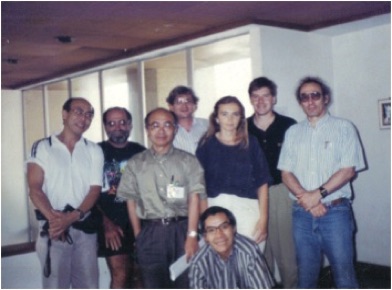
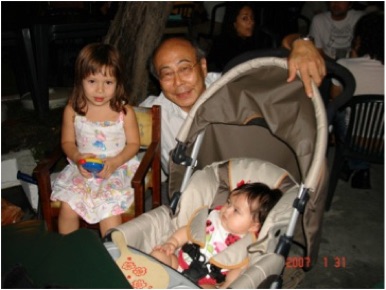
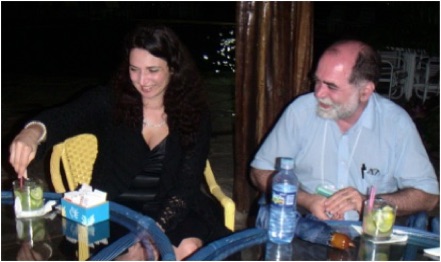
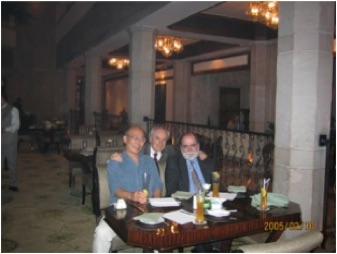
Upper Left: Takeshi Kodama, me, Yogiro Hama, Johann Rafelski, K. C. Chung, Gradzhina Odyniec, Wolfgang Bauer and Gordon Baym at an early Relativistic Aspects of Nuclear Physics Lower Left: Me and Sonya Kabana at a RANP meeting
Upper Right: Takeshi Kodma and his grandchildren Lower Right: Tekshi Kodama, Jean Paul Blaizot and me in Calcutta
Takeshi Kodama and Yoghiro are the godfathers of relativistic nuclear physics in Brazil. This and the QCD community in Brazil has grown enormously during 20 years I have been visiting. The younger generation includes people such as Sandra Padula, Frederique Grassi, and Eduardo Fraga who will be
among the leaders of this community in future years. Takeshi and Yogiro started the Relativistic Aspects of Nuclear Physics meeting, from which I recently returned. This is an international meeting
which has become very exciting with excellent attendance by the young scientists of Brazil.
During Walter Geriner’s 70’th birthday celebration in Frankfurt, I had an opportunity to teach my good friend Nu Xu, now spokesperson of the STAR experiment, how to tie a tie. Takeshi caught it on camera. (Nu is a regular visitor to Brazil and a friend of both me and Takeshi.) Please note the look of delight in Nu’s eyes once I showed him how it should be done.
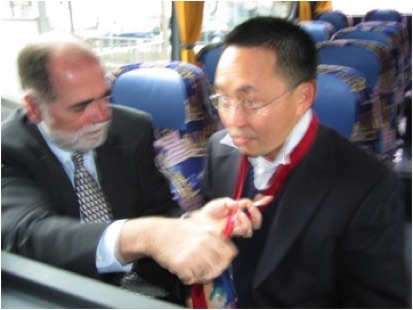

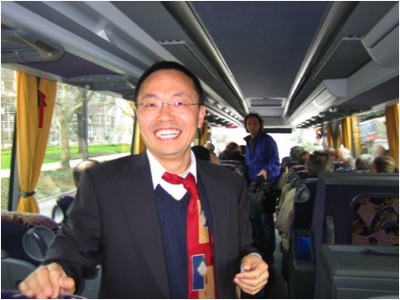
Teaching Nu Xu how to tie a tie.
(As a spokesperson for STAR, he really needs to know these things)
In 2006, I went to Brazil to attend the International Conference on Nucleus-Nucleus Collisions in Rio de Janeiro, and the International Symposium on Multiparticle Dynamics in Paraty. Paraty is a very scenic and historical town on the coast of Brazil between Rio and Sao Paolo. It is an old colonial city. It had a unique sewer system. The tides are very regular there and for a few days each month they are at their highest point. The city was arranged so that the gutters would fill with water during these incoming high tides, and when the tide receded so would the sewage. When the tide is in, it is best to walk barefoot.
The town is picturesque and filled with hotels of interesting architecture.
I was asked by Takeshi and Yogiro to do the conference summary. This is a hard job, since I had to carefully follow each talk, get copies of the presentations, and electronically join them together, and try to make a coherent picture of the meeting. I take such jobs seriously, largely because many young people give talks, and they deserve recognition for their accomplishments. Needless to say, the night before the talk, I got little sleep. I was up until 4 in the morning, which turned out to be OK because there was a fiesta going on with loud music and fireworks. It ended around 3 in the morning and when I finally got in bed, I fell asleep. In a short time fireworks went off, there was the sound of the church bells ringing, and the local priest went from door to door past all the hotels with a choir singing. The church borders on the piazza where the fiesta was held, and I fear he too was awake all night, and this was his reward for the tourists who had partied all night.
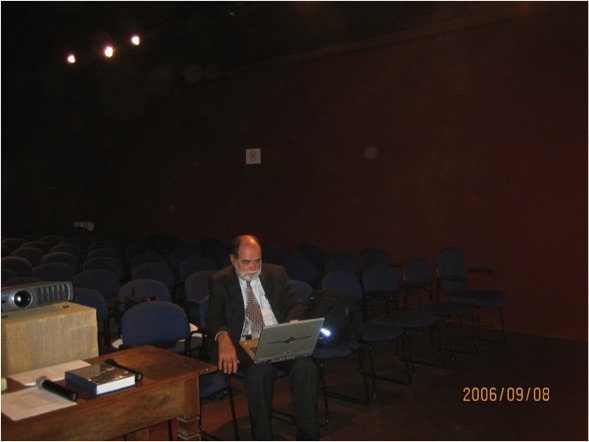
Preparing for the summary talk in Paraty. I rarely wear a suit in Brazil.
Brazil is a wonderful place to meet colleagues from around the world. I regularly have met colleagues from France, Germany, Italy, and India. Below are some photos taken from a meeting in 2004, which was held in an eco-hotel on the coast between Rio and Sao Paolo. The one on the left is Ulrich Heinz from Ohio State University, and Edmond Iancu from Paris. The one on the right is me and Jean Paul Blaizot from Paris. In the photo with Jean Paul, we are on the little boat which took us to a beach where we could swim in the morning. The photo on the left is at night during dinner. At night, the yard in front of the hotel would be full of very large rodents, the capybara. I show one below. They are real.
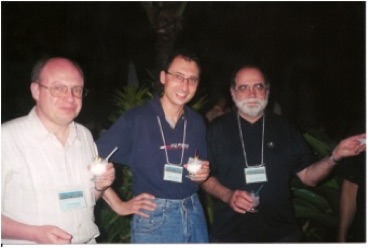
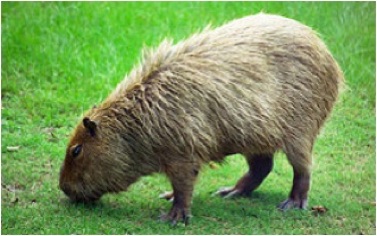
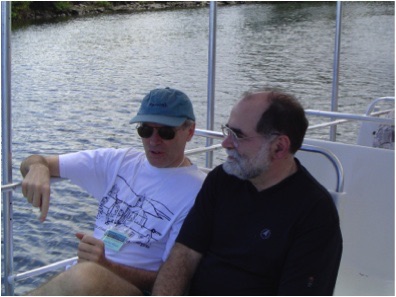
Upper left: Enjoying caipurinhas with Ulrich Heinz and Edmond Iancu.
Upper Right: Going to the beach with Jean Paul Blaizot
Left: A capybara

Top: Natasha Volshina, Alice, Me, Yuri Semenov and wife, Alyesha Anselm (forward) and wife, Nellie and Arkady Vainshtein, and Iosif Khriplovich
Middle: A get together at our home. Boris Shklovskii is to the left behind Alice and Volodya Gribov is to the right. Julia, Voldya’s wife is on the far right.
Bottom: Natasha Volshina, Alice, George Savvidy, me, Alex Khodjamarian, Sergei Voloshin and wife and Iosif Khriplovich
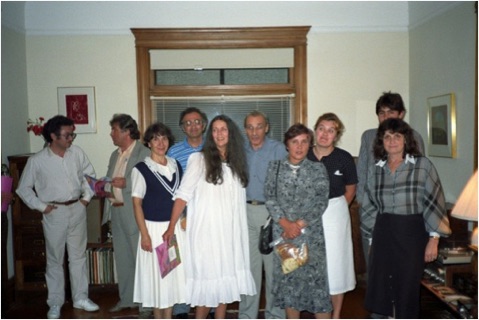
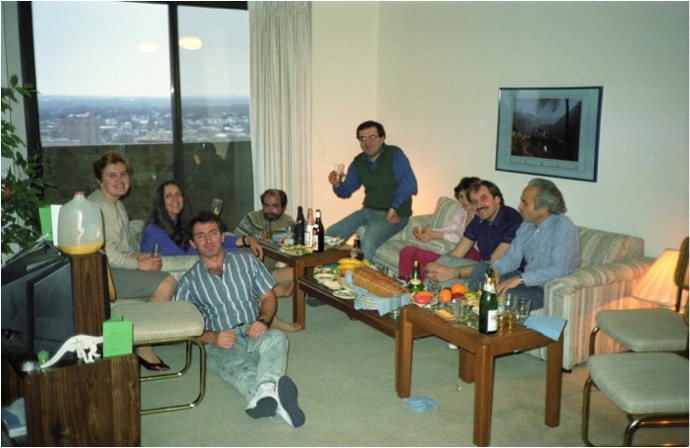
The first Russians I got for long term visitors were particle physicists. After about a year, I also invited condensed matter theorists Boris Shklovskii and Leonya Glazman to visit us. At the end of the first year, we made offers to Arkady Vianshtein, Misha Voloshin, Misha Shifman, Boris Shklovskii and Leonya Glazman. There were a variety of different way that people arranged their appointments with their institutions in Russia.
I had excellent relations with the visiting Russians and those who ultimately remained at Minnesota. We had many parties together; we would go together canoeing or cross country skiing. On one of these expeditions, I discovered that Nellie Vainshtein called Arkady Arkadinka, and sometimes Arkaka. This led to me calling Arkady “Milaya Arkdinka” which roughly translated means “My Dear Sweet Little Arkady,” although using the wrong gender for the adjective. Arkady did not like this, but he had his ways of getting revenge. Arkady and I also had birthdays on the same date, and would have joint birthday parties. Photos from some of these are shown in the Alice section.

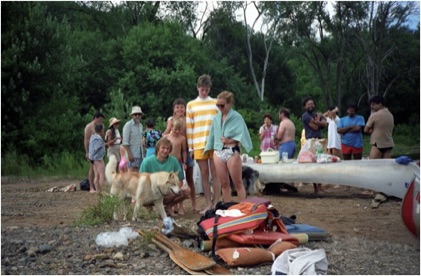
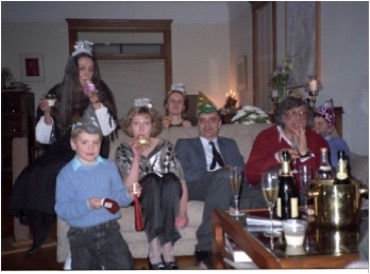
Upper Left: A day in the park with the Volshins and the Semenovs
Upper Right: The Volshins, Vainshteins and Novikovs on New Years Eve
Left: The annual canoe trip. In the background in blue is a young Raju Venugopalan with a full head of hair
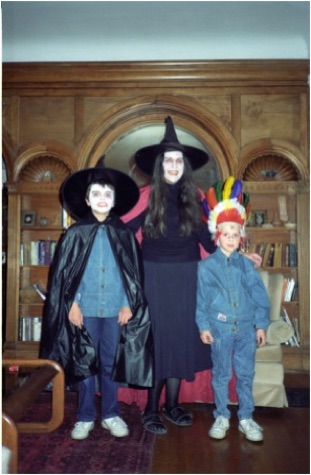
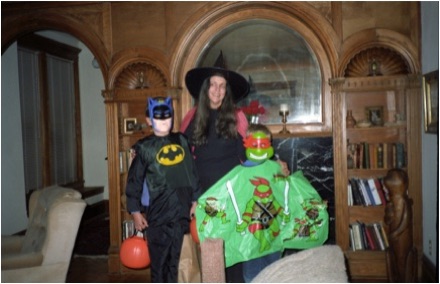
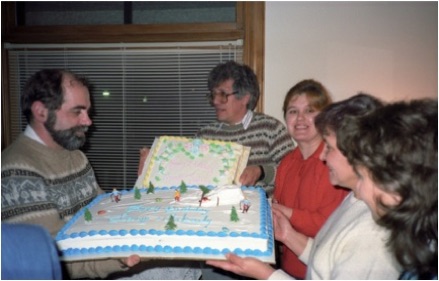
Above: Alice and the Mishenka and Alyesha Voloshin preparing for two successive Halloweens
Right: Me, Arkady, Natasha Volshina, Nellie Vainshtein and her daughter celebrating a joint birthday for Arkady and me.
My best friend in Minnesota is Misha Voloshin. Misha is a brash and brilliant theoretical physicist. When you ask him a question, his response is “How can you possibly ask such a stupid question? Every graduate student in Moscow knows that....” One of the essential items which the Russians needed to learn in Minnesota was to drive. Misha got a learners permit and a car. At night, his children would go out in sit in the car, pretending to drive in anticipation of Misha’s receiving his license. I took him to his first exam, and he failed the driving part of it. This was a total disaster for Misha, who I think had never gotten a score less than A+ on any exam he ever took. I then began going out with Misha every night for about two weeks, where we drove around corners, parallel parked, and backed up endlessly. It was a good time of male bonding. I was cruel however to Nataha, Misha’s wife, who was I think a little disappointed when Misha failed his first test. On returning back after Misha had passed and received his license, I lied and told her that Misha had failed and that he was told not to come back for a year. I did not torture her for more than a few seconds, and I think she has never forgiven me.
George Savvidy is a person of great joy with a true love of life. He loves to tell jokes, but while at Minnesota, his English was not so good. When he told a joke and got to the punch line, people would stare with blank faces trying to understand his point. One day at lunch he began telling jokes to a Japanese visitor, who had minimal English skills. When George told a joke, the visitor sensed the punch line, and would politely laugh. George would then tell another joke, getting more excited since he finally found someone who appreciated a good joke. This went on for several hours. After this, he and the young Japanese visitor become very good friends.
With the Russians at Minnesota, it was a very good place for me to do physics. I became involved in a project to understand high energy scattering in electroweak theory. We followed a conjecture by Andreas Ringwald that non-perturbative processes in electroweak theory might make events where large numbers of the very heavy particles associated with electroweak theory might be produced. These events would be spectacular, and naively, it appeared they occurred with a high rate. After several years of work from our group at Minnesota, Andreas Ringwald in DESY, Al Mueller at Columbia University and Valery Rubakov’s group in Moscow, it was established that the rates for such processes are very small. This led to some understanding of non-perturbative processes in field theory, but the end result was disappointing.
I had been working on problems related to electroweak baryogenesis before leaving Fermilab. I continued this with Misha Voloshin and Misha Shaposhnikov who was visiting Minnesota. We developed a mechanism which might lead to large enough amount of baryon number to explain the matter asymmetry observed in cosmology. This turns out to be one of many possible mechanisms which were subsequently developed.
I think the most important thing I learned from my Russian colleagues was that if you have a good idea in physics, you should carry it to completion, even if it takes many years. My philosophy prior to coming to Minnesota was to work in an area for a few years, and then move into another set of problems. My Russian friends convinced me by example that one has to have real conviction about the problems that you consider to be important, and such conviction implies a commitment to see a problem through to completion. They also showed me that one should never be frightened to attack big problems which appear to be hard to solve. Most important is trying one idea, and then another, and then another until the problem yields.
I also became very good friends with a widening set of Russian colleagues. Vadim Kuzmin, of the Institute for Nuclear Research was the intellectual and spiritual father of the theory group at the Institute for Nuclear Research in Moscow, is shown below. He was the mentor of Valery Rubakov and of Misha Shaposhnikov. Vadim visited for extended periods of time, and while there made some beautiful paintings, one of which now hangs in my office at home. I visited this group many times and attended the Quarks meeting run by his group.
University of Minnesota: 1988-2000 (Continued)
I have had a long and very happy experience with France and French scientists. When I was a graduate student, Tran Thanh Van and Alfons Capella from Orsay would visit the University of Washington and we became friends. Both are well known for their work on the theory of high energy scattering, and as a graduate student I was working on ideas they developed. While at Stanford Linear Accelerator Center as a postdoctoral fellow, I became interested in high energy nuclear collisions, and Tran and Alfons made notable early contributions to the theory of such processes. Tran is the organizer of many famous meetings including winter meetings in the French Alps on a variety of topics in high energy physics. These meetings were among the the few which included the theory of nuclear collisions and properties of matter at high energy density under the umbrella of a high energy physics meeting. I began going to these meetings, and later became one of the organizers of the Moriond meeting about QCD and Strong Interactions.
The Moriond meetings of my youth took place in Les Arcs, France. This is a beautiful area of mountains just to the west of Mount Blanc. I learned most of what I know about skiing in Moriond, met a large number of excellent scientists with whom I have collaborated and shared ideas throughout my career. I came to know Tran as a gracious host of sophistication in science, culture and food.
Early in my career, I became friends with Jean Paul Blaizot. Jean Paul is a warm human being with a deep understanding of people, organizations and science. I think what makes us such good friends is not our common strengths, since I am handicapped by my inability to understand human nature and organizations, but because of our common love for science, and our enjoyment of the human comedy. I think I first got to know Jean Paul during a visit to Paris in 1985. We wrote a largely unknown paper about jet quenching in heavy ion collisions, long before there was much interest in the subject.
This was the first time I was in Paris for any time, and Alice had received information from friends about hotels in which to live. My sister Jennifer came along with us. (There are pictures of Jennifer during this visit in the McLerran’s section.) I had been attending another meeting before coming to Paris, and arrived late in the night to the hotel where Jennifer and Alice were staying. The Hotel was enclosed by a tall wall, and the gate through which I needed to enter was locked. It was a small hotel with a reception that closed early. After I had been standing around helpless for about ten or fifteen minutes not knowing what to do, I suddenly saw someone through the gate -- Jennifer! She had been sleepless and was walking around, and was able to open the gate and let me in.
We soon moved to a better place to stay in the Latin Quarter which Alice had found. It was on Rue Tournefort, in a collection of small apartments run by three old ladies. Our apartment was on the top floor just under the roof, and had a view over the rooftops of Paris. The old ladies were well known in the neighborhood for their argumentative dispositions. I found them charming. They had a little dog which chased after me when I left for the lab every morning. His owners would yell in warning, “Le chien, le chien!” He would chase me out the door of the Residence Parisienne barking and growling, and the ladies would say something in French, scolding the dog. The dog was very smart, and understood that the best part of the chase was not in catching me, but in aggravating his mistresses, who would soon hold him gently in their arms whispering things in gentler tones, encouraging him to more civilized behavior. When we left Paris for the US, I bought the ladies a large bouquet of flowers. I should perhaps have brought a bouquet for each of them. As I was leaving the Pension, they were loudly arguing over to whom I had intended to give the flowers.
This visit began my love of Paris. It is a wonderful city. The people are kind and generous. You need only a very little French to survive. Most important is to remember it is a Latin country, and much communication is by tone of voice and the way you hold your body. If you are pushy, nothing will work.Alice remembers being at a train depot where some American went to the window where one buys tickets, and asked some general question unrelated to trains. The man who sold the tickets spoke no English, and did his best to explain that. The Americans simply repeated their question more loudly, as though that might enable him to understand. The clerk shrugged sadly, gesturing with his hands his helplessness to do so.
Alice was next in line, and began her encounter by answering politely his courteous, “Bonjour, madam.” She had come to enquire about train schedules to Giverny, to visit the house and gardens so often painted by Monet. She spoke little more than a few words of French, but the two used gestures and at one point a sketch, and by the time she left the window she had not only the tickets she needed, but the information that it was rather far from the Giverny station to Monet’s former farm, now a museum, so that it might be convenient to take a taxi there -- and that if she arrived before the museum opened, there was an inn just across from it where we could have coffee.
For about 20 years, I have gone to the same wine store in the Latin Quarter. The man who runs the store knows me. I speak little French and he little English. Nevertheless we can communicate, he will always find a good wine for me -- and we like one another.
I do understand a small amount of restaurant French, and Alice and I have gone to the same restaurant many times since our first visit to Paris, Le Petit Chatelet, which is shown in the picture below. The owner is very nice and treats us like family, even though he has to help us with our French. The restaurant is right next to Shakespeare & Co., a book store on the left bank just across from the Notre Dame. One warm March night, I remember sitting outside having dinner listening to choirs singing outside Notre Dame, and seeing lights from passing boats on the Seine reflect on the Notre Dame and the river embankment. I was enjoying myself, but eventually realized that the owner was a little worried since I appeared without Alice. I made a point of telling him that she had been unable to accompany me on this trip but was quite well. This restaurant is a little more pricey than its neighbors, but it is well worth the difference.
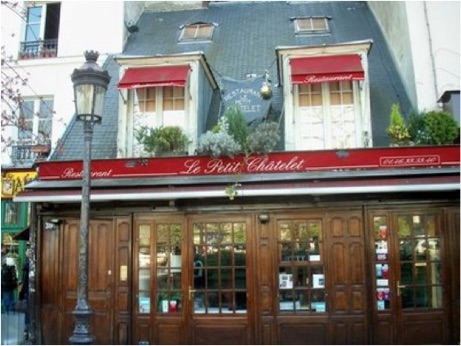
La Petit Chatelet in the Latin Quarter
The first visit to Paris was about 8 years before Edmond Iancu appeared on the scene at the Center for Atomic Energy in Saclay. Edmond was at the time a young colleague of Jean Paul Blaizot. Jean Paul, with his incredible insight into human nature, decided that we would work well together. However, we needed proper introductions. This involved getting together with Edmond for about an hour to have Edmond talk with us about physics. Edmond is well known for being one of the fastest speakers alive, and he can do this in French, Rumanian or English. Jean Paul carefully arranged a room where we could talk. It was a small seminar room, and Jean Paul sat in one corner in the back and I sat in the other corner. Edmond was presenting his work on the blackboard. It was quickly apparent that if we were to understand what Edmond was presenting, Jean Paul and I would have to slow him down. This we would do, by Jean Paul asking a question and while Edmond answered it, I would have the time to think through what he had said before being so distracted. I would shortly after ask a question and Jean Paul would have the next chance. This format continued for a few days until Edmond one day turned around and angrily accused us of ganging up on him. We pretended we did not understand.
I have had many pleasant collaborations with Edmond. They are somewhat stormy, as good collaborations should have such relationships. Once Edmond visited me in Minnesota for several months. A few years later, one of the visitors in the office next to mine told me the pattern of the encounters he overheard. He said that early in the day, Edmond would come into my office. For a while it would be quiet. Then there would be the sound of chalk scratching on my blackboard, which would continue to get more intense. Then he would hear a loud high pitched voice (Edmond) getting louder, and increasingly violent sounds of chalk pounding on a blackboard. Finally, there would be a deep voice (mine) which would simply say “Bullshit”. Then there would be quiet for a while, and the whole sequence would repeat itself. He said this went on for many weeks, and he was never sure what we were really doing.
I have benefited enormously from collaboration with Edmond. He has an uncanny ability to turn abstraction into concrete computation, and he will never accept a wrong argument. He is a unique human being with great talent as theoretical physicist.
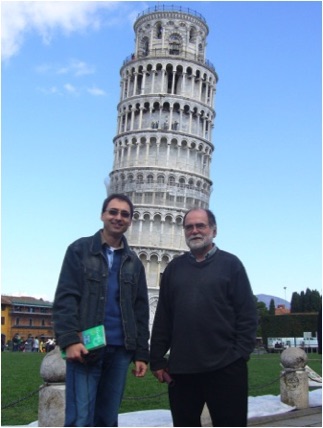
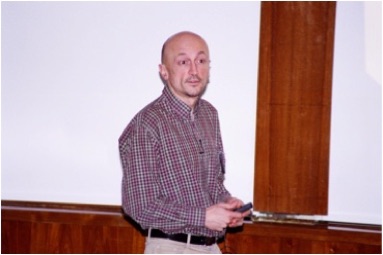
Left: Edmond and in Pisa
Above: Jean Yves Ollitrault giving a lecture at the Tata Institute in Mumbai, India.
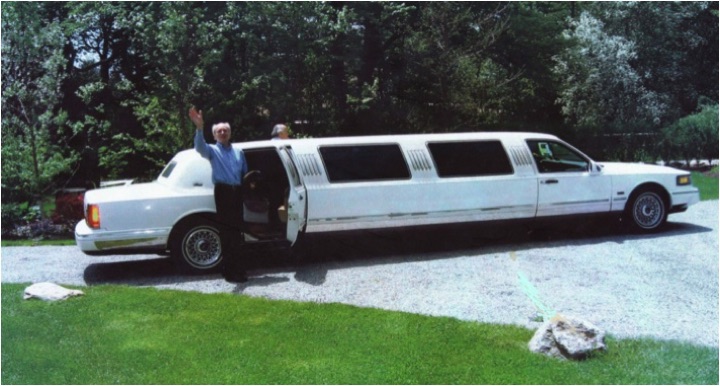

Above: Jean Paul Blaizot pays a visit to my home in Bellport.
Left: Ernie Moniz and me on a ski down La Vallee Blanche on Mount Blanc taken during a school we lectured at in Les Houches
Another good friend we met on the early visits to Saclay is Jean Yves Ollitrault. Jean Yves has the disposition of a poet, and is very refined in all issues intellectual and artistic. Alice says she likes watching him as he talks, because his face expressed nuances of emotion in a manner that is at the same time subtle and expressive. He is very diplomatic: he always tells me I am wrong in a way that allows me to think I have discovered the error myself.
Jean Paul Blaizot and I have developed things that may begin as private jokes, but then develop a life of their own. Perhaps our favorite is the Pinnochio Award. It is given to the person who tells the biggest whopper at any Quark Matter meeting. This meeting is the central scientific meeting of our area of research. It is held every one to two years. For many of these years, the Award Selection committee has met in secret and selected the Laureate. There are only two members of the committee: Jean Paul and me. We have several rules. The most important rule is that we are not allowed to nominate ourselves for the award. This, among other things, prevents a divisive discussion. The second rule is that the award can only be given to a person who believes the whopper is true when he or she says it. This prevents people telling a big lie only to win the award. Finally, repeat award winners are discouraged, for obvious reasons, although for an exceptional series of contributions we have awarded it twice to one person. Over the years, many distinguished theorists and experimentalists of our field have been nominated for the award. For some time, we gave a Pinnochio doll, sent anonymously through the mail, to a recipient, but we felt that such a tangible aspect of the prize was not fully appreciated, since only in one case did we see the doll prominently displayed.. Alice has bought me a very beautifully carved Pinnochio doll, with lanky jointed limbs and large hands that can assume a variety of expressive postures. He normally sits on a shelf our living room but on some occasions may be seen in seminars or talks at international meetings.
Left:
A young Raju Venugopalan and Joe Kapusta in about 1994.
Bottom Left:
Heribert Weigert
Bottom:
Alex Kovner and the late Ian Kogan
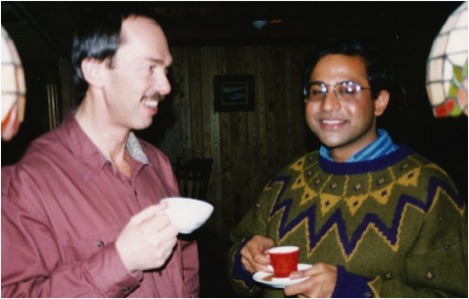
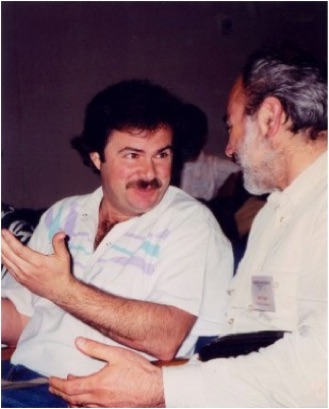
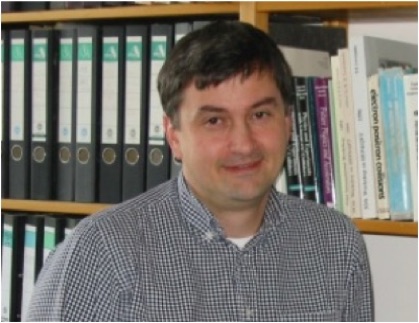
During the time at the University of Minnesota, I collaborated with Joe Kapusta on a few papers, but largely we worked independently with the young postdoctoral fellows. The strongest collaboration I developed was with Raju Venugopalan. We developed the seminal ideas for the Color Glass Condensate. Later with Heribert Weigert and Alex Kovner, we developed the seminal ideas for the Glasma, During the visits of Edmond Iancu, we made some really deep and fundamental progress on these concepts. These ideas are described in the Physics section. This was en exciting time for me, working with absolutely first rate young people on ideas which were so new that for about five or six years no one, except Al Mueller and his then-student Yuri Kovchegov at Columbia University, and Genya Levin at University of Tel Aviv, paid any attention to them at all. I think it is fair to say that these ideas are now widely known, if not yet universally accepted.
Of course the name Color Glass Condensate evokes other images besides the strictly scientific ones. It allows you to say thing like “during heavy ion collisions, when two sheets of colored glass collide they shatter into fragments of glasma.” And of course, for a variety of reasons involving both taste and scientific priority many people (and some few still do) resist this name. For me, it was a great time to tease my colleagues. One of the standard expressions was “seeing the world through colored glass”. An important turning point in the acceptance of these ideas was workshop held at the European Center for Theoretical Nuclear Physics in Trento on the early part of the new millennium, organized by Boris Kopeliovich. I have pictures below of the dinners for this meeting.
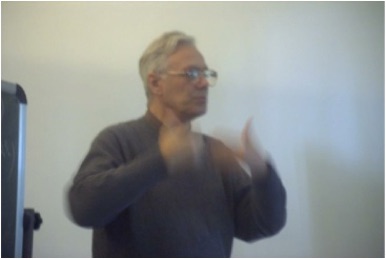
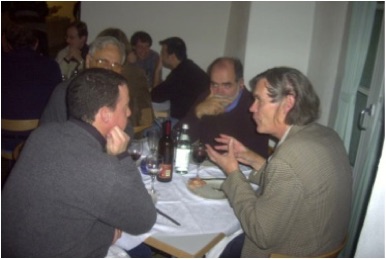
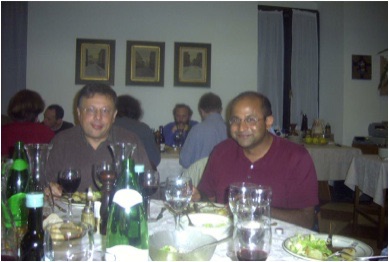
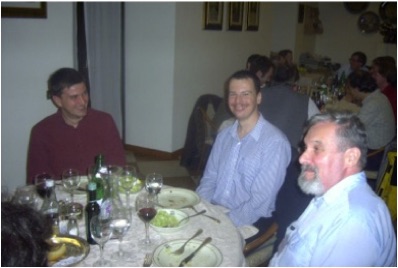
Top left: Genya Levin giving a “hand waving argument”
Top right: Genya Levin, me, Al Mueller and Yuri Kovchegov
Bottom left: Eduard Shuryak and Raju Venugopalan
Bottom right: Heribert Weigert, Yuri Kovchegov and Mikhail Braun
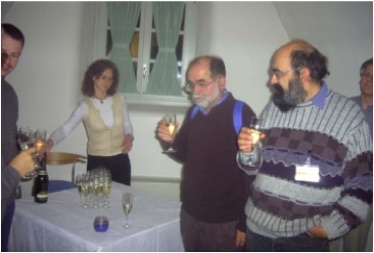
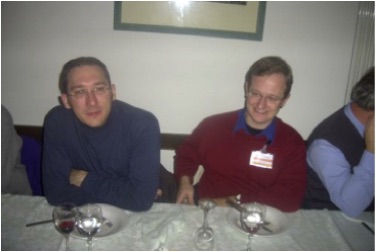
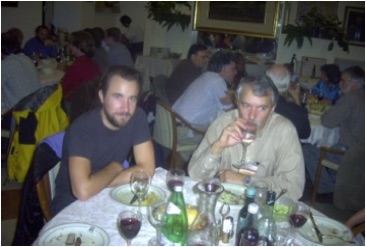
Upper left: Me and Joerg Aichelin
Upper right: Francois Gelis and H. van Hees
Left: Carlos Salgado and Ian Balitsky
Below Left: Boris Kopeliovich discovers Colored Glass
Below Right: Jean Paul Blaizot (with Colored Glasses), me and Ismail Zahed
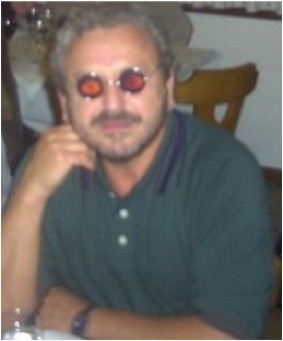
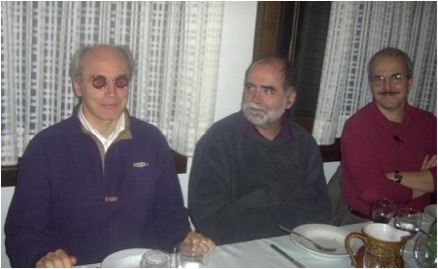
During the time in Minnesota, I was also on the Board of Trustees of the Aspen Institute for Physics. I was going there just about every summer from the time I first went to Fermilab until the middle of the time I was in Minnesota. I eventually stopped going because of other commitments for travel, and because Alice and I bought a second home in Sunriver, Oregon. Aspen was a great place to meet people and do science. On weekends, we would get together to go on backpacking or hiking expeditions. I knew many off-trail lakes which were hard to reach but full of cutthroat trout. Many of our Russian friends would visit Aspen, as there was an official program for Russians at the Aspen Institute, and I would take them to these favorite lakes. My good friend Misha Shaposhnikov quit smoking after one such adventure, he was so exhausted after climbing to a top of a ridge -- and I had actually beat him to the top.
I remember descending a very steep fisherman’s trail from Truro lake with a young Korean visitor Chisup Kim. I could sense that looking down he was frightened, although he did not say so. In fact he said nothing at all until we reached the bottom -- where we broke into friendly relaxed conversation. Fear makes good friends. Our grandchildren visited us there in the summer, visits which continued in Oregon when we got the place there. It was in Aspen, however that they began to learn to hike, fish and camp.
I was also on the Board of Directors of the European Center for Nuclear Theory in Trento, Italy for four years in the early formative stages of the institute. There were many spirited discussions about funding, directors, and the direction of the Center. At that time, it was not clear that the Center would survive, as getting funding from the various European funding agencies was difficult. I remember after one long meeting telling my friend Jean Paul Blaizot who was on the Board that “sitting for a whole day being nice to everyone gave me a big headache”.
The Institute for Science and Culture of Trento provided major funding, and rehabilitated a Villa on the edge of Trento. I saw how skilled artists restored aged frescos, guided partially from remains on the wall and partially from old photographs. My good friend Dominique Vautherin was Chairman of the Board for much of the time I was on the board. Toward the end, he developed brain cancer. His French friends, particularly Sidney Gales, got him the most up to date therapy, but it proved possible to provide only a few brief months elongation of his life. The cancer he had was fast moving and deadly. Dominique was a person who loved life and science. I miss him still for many things, but especially for the gentle use he made of his unusually deep insight into others.
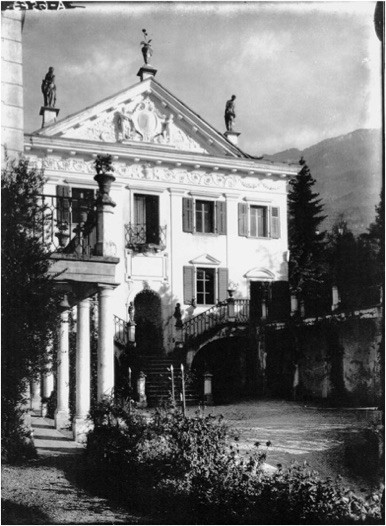
Villa Tambosi in Trento
During the time in Minnesota, we had many visitors. Two families from India came and stayed for about a year on their sabbatical, the Srivastavas and the Gavais. We became good friends, and remain so.
Dinesh Srivastava is not a typical Indian scientist. He started out in low energy nuclear theory. He was one of the few with such a background who made a successful transition to high energy nuclear theory. He did this largely unaided. Dinesh is very assertive, does not tolerate nonsense, and is horribly un-diplomatic. In this respect he is more American than Indian. He likes good Scotch whiskey, and a good joke. I remember once he was very angry with me. He was computing a very rare process. I asked him how rare. He quoted me some numbers, and they let me figure out that one could expect about one event for every ten million years at the highest flux accelerator one would contemplate building. You can guess the prize for which he was a prime candidate. Dinesh was never very happy with this story, and whenever he hears it told says something mean to me.
I met Rajiv Gavai while he was a young man visiting the Univerisity of Bielefeld. Rajiv works at the Tata Institute in Mumbai, and is the father of lattice gauge theory in India. By nature he is iconoclastic, but also a man of great tact. You do not know he is out to kill your idea -- until he kills your idea. And then, unlike a zombie in the Night of the Living Dead, it does not get back up and walk around the room. Rajiv was in Minnesota with his wife Rujuta and two young sons Gaurang and Vinni. These young fellows are now young men. Always in India, I like to take Rajiv’s family out to dinner somewhere nice in Mumbai, and I try to find out what his children are thinking. Rujuta is an excellent cook, who has a subtle taste with Indian spices. She understands I absolutely love her cooking, as I have never eaten finer Indian food than in her apartment.
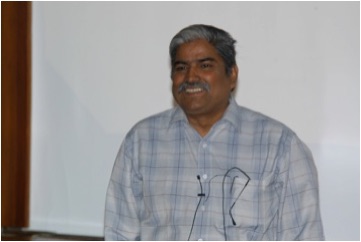
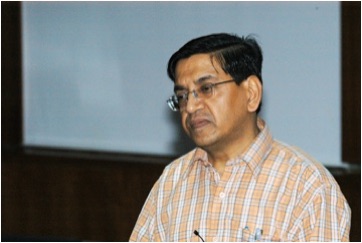
Left: Dinesh Srivastava Right: Rajiv Gavai
I recruited Yuri Kovchegov at the University of Minnesota. I had to work hard to do this: Yuri had an offer at Brookhaven Laboratory. I invited him to visit the University of Minnesota, and in addition to introducing him to the intellectual life there took him cross country skiing. Keeping up on cross-country skis with a Russian of any age is hard, but with a young Russian. . . . Somehow we became good friends. Our way of relating is a bit strange: it involves basically trading Russian style insults with one another. I keep meaning to treat Yuri with more respect, but every time I meet him, he provokes me, and I cannot resist, and there we are back again in Minnesota.
In 1996, I was invited to a conference in George, South Africa that also was a celebration of the 60th birthday of Walter Greiner, who is the most influential of German theoretical nuclear physicists. I describe Walter above in the Anecdotal Vita, as he sponsored me for an Alexander von Humboldt prize early in my career, which I used to sponsor several visits to the University of Frankfurt. I gave the after dinner talk at Walter’s 70th birthday a few years ago in Frankfurt. The talk and the original power point presentation for this is covered in the Anecdotes section. Walter is a most valued friend whose kindness and intellectual leadership have been an inspiration for me.
George is on the South African garden coast. Our hotel was near the sea, and at night I could walk along the Indian Ocean staring up at the stars of the Southern Hemisphere which I had never before seen.
During this visit I stopped at the University of Capetown to visit my good friend Jean Cleymans. Jean introduced me to his student Azwindinni Muronga. I liked Azwindinni immediately. I first had a conversation with him about work he had been doing. I challenged him, asking questions about the ideas at the basis of his work. I do not think Azwindinni was used to being challenged. What I liked is that under attack he did not retreat, but tensed his muscles and fought with me over each concept. It was a remarkable performance for a man as young as he. I later found out that Azwindinni wrote plays. Even more remarkable, he was the son of farmers in a rural part of South Africa. His older sister had become a nurse, and she encouraged Azwindinni to get an education.
I arranged for Azwindinni to come to the University of Minnesota as a graduate student. When he first arrived, he had no decent housing. Alice worked with the University to get him a room in a special dorm where they largely housed football players, and his initial roommate was given to late and noisy partying in their shared room. Alice persisted, and soon he was moved elsewhere, and given a quiet and studious roommate.
I was surprised that after a little while at the University he was not performing as well on his exams as I had expected. (I had assumed he would be at the very top of his class.) I talked to him and discovered the problem: he began by looking at an exam and then ordering the problems from hardest to easiest. He would then begin by trying to solve the hardest working towards the easiest. This of course made the exam more challenging for him, but did not let him optimize his score since it increased the possibility that he might not get to every question.
I remember one night at a dinner party he described how he would go hunting as a young man. This involved stalking an animal. He told me that he also understood that while he was stalking there were other animals stalking him.
Azwindinni returned to South Africa and became a professor back in Cape Town now. He did postdoctoral work with Walter Greiner’s group in Frankfurt. During this time he did seminal work developing methods for solving relativistic fluid dynamics equations. It is very nice and innovative work. When he went back to South Africa, in the letters I wrote to those at the university I emphasized that Azwindinni should be left to do physics and, at least for a while, should not be encouraged into academic or national politics, since he is a really good scientist and should be allowed to develop as such. Much later, when he understands what world class science is about, then if he chooses, he might become involved in trying to make the system work better for people of his background. Remarkably, the University of Cape Town and the South African funding agencies understand this, and he is becoming a very strong scientist of world renown. I expect that with time, Azwindinni will have a many-faceted life. A man with his energy and intelligence can do just about anything he chooses to do.
In recent years, he has moved tothe University of Johnnesburg. He is director of the Sceince Museum in Soweto.
He is winning all sorts of prizes for his work in promoting science education., He also finds time to do good physics
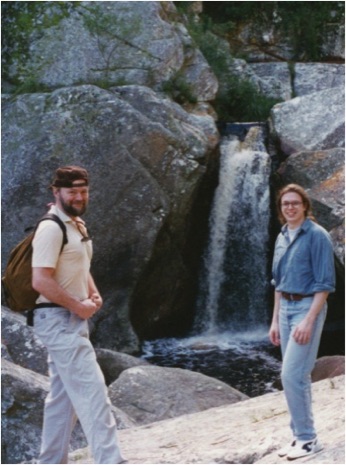
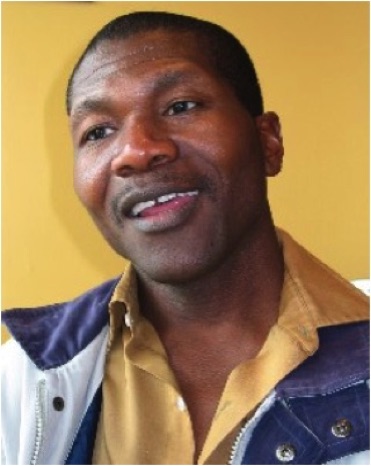
Left: Miklos Gyulassy and Juergen Schaffner Bielich in George South Africa.
Above: Azwindinni Muronga at my home in Bellport in 2007
Left: Azwindinni winning the NSTF, BHP Billiton Award for cultivating a culture of science, 2014
Late in my time at Minnesota, I was offered a professorship at Nordita in Denmark, a position previously held by Ben Mottleson. Nordita is loosely affiliated with the Niels Bohr Institute. I eventually turned down the position. The salaries in Denmark are low, and we could not have afforded to keep our house in Oregon had we gone there. For several years, however, we visited Copenhagen, including three months during a sabbatical stay.
The time in Minnesota was very good for me. I learned how to work on hard problems, and had many very bright young people with whom to work. In addition to those mentioned above, there were young postdoctoral fellows Klaus Kinder Geiger, Dietrich Bodeker, Larry Carson, Rang-tai Wang, Sangyeong Jeon, Axel Vischer, and my students Bao-hua Liu,, Jamal Jalilian-Marian, Alejandro Ayala Mercado, and Xu Li.
In 1999, I was offered a position at Brookhaven National Laboratory. This time they made me an offer I could not refuse. I would have the resources to build a group. Alice and I were worried about finding a place to live where she as a non-driver could function, and the move at first seemed especially difficult because we had recently bought a condominium in downtown Minneapolis where she could walk to everything. Nevertheless, we both understood that this was an opportunity to build a group in an area where I had made seminal contributions. I accepted the position.